
Squinting in the harsh mid-day light and holding my breath, I rolled this rare machine I had been entrusted with across the grassy clearing.I leaned it against a tree. I arranged it amidst some flowers. Ipositioned it this way and that, in the sunshine and in shadow. With the camera to my eye, I crouched, I kneeled, I loomed, I stepped back. And yet, the bicycle refused to draw attention to itself. It was as if in his quest to achieve harmony - a harmony of proportion, colour and form - the builder had gone one step too far. So harmonious was this bicycle, so perfectly at home in these woods on this beautiful spring day, that it was in fact part of the scenery.

To appreciate a JP Weigle, one must appreciate this level of subtlety.
There is no Weigle website. Just some flickr pictures, minimal publicity, word of mouth, and one of the longest wait lists in the business. Because to
those in the know, the builder's name is synonymous with randonneuring machines in the classic French tradition, made to the highest standards.Today this style of bike is not as rare - and, by extension, not as striking - as it was just a few years ago. There are fewer heated debates about its low trail geometry and 650B tires. There are also fewer oohs and aahs about its integrated fenders, racks, lighting, handlebar bags and other iconic features. But a Weigle machine is not so much about these things in themselves, as it is about how they are done. They say thatWeigle is the master of the thinned lug, of the French-curve fork blade, of the sculptural, minimalist front rack, of the near-invisible internal wiring,of the perfectly installed fenders. Hardly anyone uses the word "beautiful" to describe his work, although it is assumed. The words used are: meticulous, impeccable, flawless.It is by design that no part of a Weigle calls attention to itself.
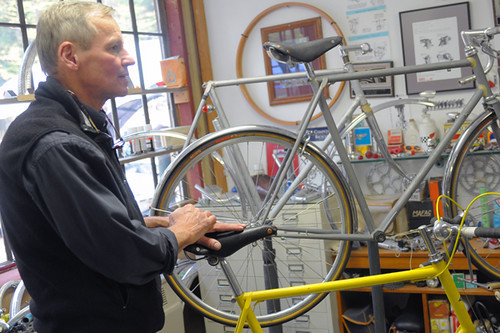
In his ruralConnecticutworkshop, JP (Peter) Weigle has a presence that is as quietly compelling as one of his creations. Dressed in gray on gray and of serene disposition, he is easy to miss in a room full of colourful jerseys and animated conversation."But where is Peter?" visitors ask. Eventually he is spotted, in a corner, speaking in a muted yet impassioned tone as he points to some tiny detail on either his own frame or a vintage one in his custody. On my visit I was treated to a Jo Routens, stripped of paint, its brazed joints exposed to be studied. And beside it was the yet-unpainted bike I was trying to photograph now - nearly ready.

The future owner, Elton (second from the left), left the paint colour up to Peter, confident that whatever the builder chose would be right for the bike.
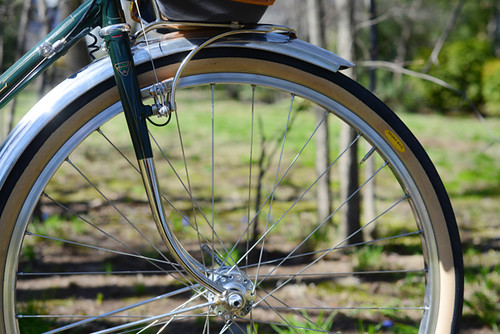
The racing green frame with nickel-plated fork blades and stays is a congruent combination of darks and lights, of matte and reflective surfaces.
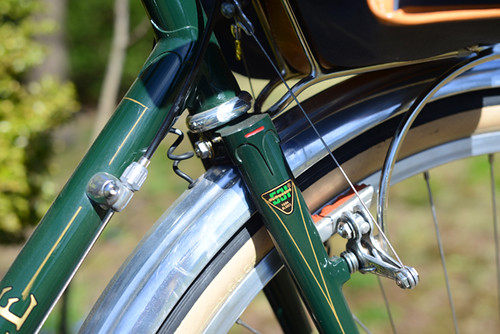
The embellishments - such as the lug cutouts filled with tiny bursts of red and the golden box lining - are noticeable only on close inspection, but are so numerous and discreet that one could spend hours looking over the bike and still miss some.
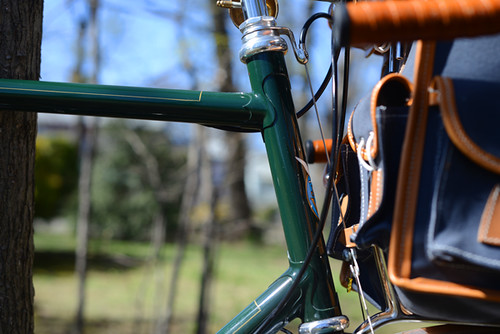
The lugs are thinned out to such an extent, that they are almost flush with the tubes. It is difficult to get their intricate shorelines to show up on camera. No doubt it is to highlight this aspect of the construction that lug outlining has been omitted.
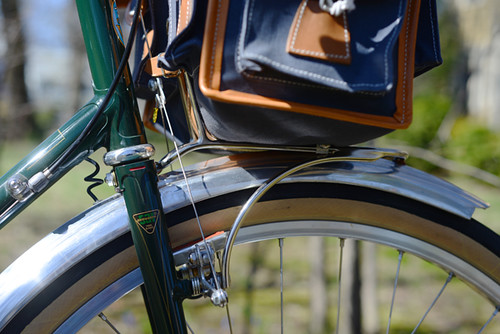
In addition to the frame and fork, Peter made the canti-mount front rack

which features a left-side light mount extension

and sits low and stable on the bike, the platform secured to the front fender.
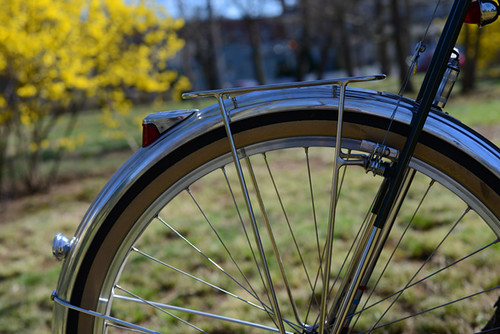
He also made the rear rack,
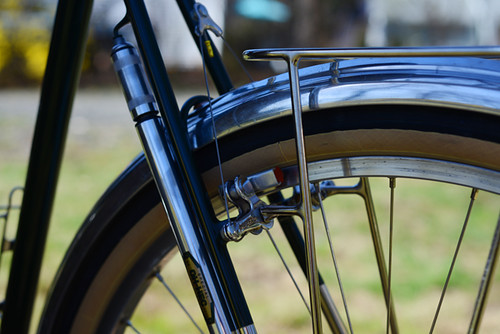
which attaches both at the dropouts and at the canti bosses.

The custom cable hanger and tail light are also his own work, as is the reworked ("Special OH-HEC") pump - poorly pictured here, but lovely.
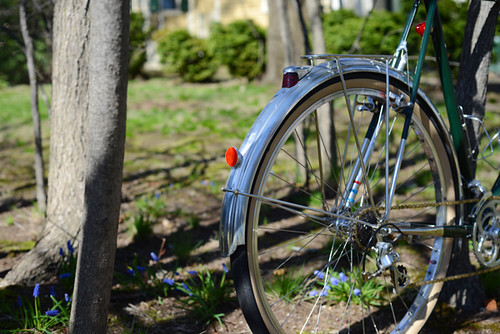
The internally routed dynamo-powered lighting was set up in collaboration with AT Électricalités - aka "Somervillain," who now moonlights as a bike electrician of renown skill. He explains how he set up the lighting step by step here. Examining the bike in person, the entry and exit points of the wiring are extremely difficult to spot even if you know where they are.
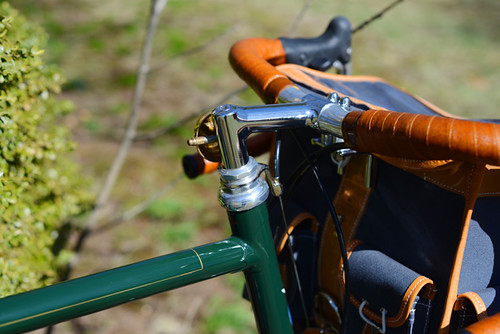
The rest of the build the owner put together himself. It included a Grand Bois stem and decaleur,

modern Rene Herse crankset,

Shimano Dura Ace rear derailleur and cassette,

9-speed Campagnolo ergo shifters,
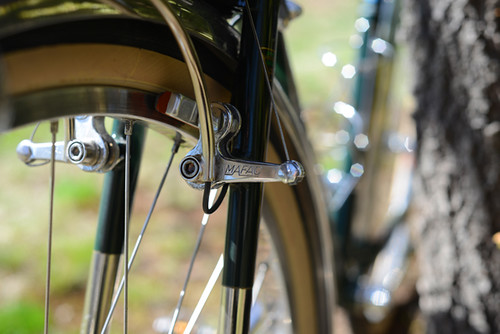
vintage Mafac brakes

Handbuilt wheels around Pacenti rims, with a Chris King hub in the rear and a Schmidt SON dynamo hub in the front, and of course Grand Bois Hetre (extra leger!) 650Bx42mm tires,
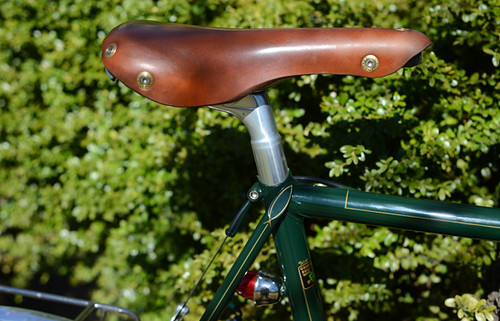
Gilles Berthoud touring saddle,
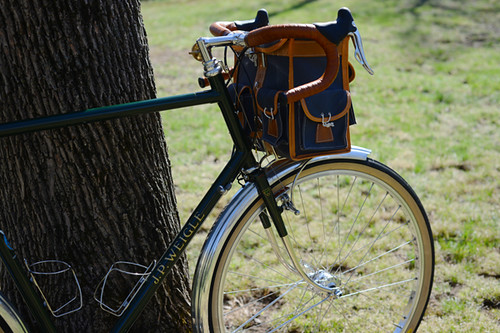
Berthoud handlebar bag,
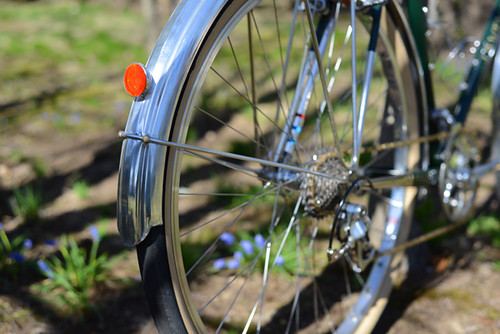
and long coverage Honjo fenders, which Peter Weigle installed using his own special method prior to Elton doing the rest of the build.
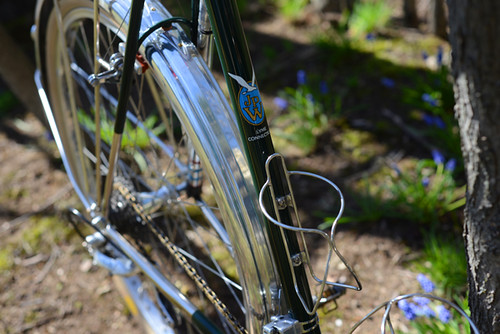
The elegant Nitto bottle cages are a nice complement to the build,
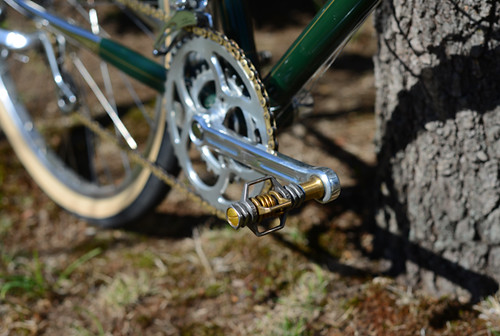
as are the two-tone Crankbrothers pedals and Wippermann chain.

Even after such a long description, there are many details I've missed. I need a clearer background and softer lighting to really do justice to it all. The curve of the brake bridge, the hidden lug cutouts, the pump peg, the delicate little braze-ons... this is a bike whose beauty "unfolds" the more closely you look at it. But standing there in a patch of woods, it makes you think about cycling rather than its own self. And Elton surely has plans to do some brevets on this beautiful machine this season. In the meantime he has been commuting on it to work.
 Living in New England, I've been lucky enough to encounter a few Weigle bikes "in the wild" (for example,
Living in New England, I've been lucky enough to encounter a few Weigle bikes "in the wild" (for example, this one
), made over the span of several decades
. Like a number of other well known American builders, Peter Weigle got his start at Witcomb Cycles in London, UK in the early 1970s. And w
hile today he is best known for his low trail randonneuring machines with 650B wheels, he did not begin working on such designs until 2005-2006. Before then there were Weigle racing bikes, mountain bikes, touring bikes - all showing the fashions of the times, yet also his distinct brand of elaborately subtle detail. I feel fortunate to have seen some of these bicycles and spoken to their owners.
Peter Weigle's small workshop in the woods is neat and tidy when visitors appear. The builder's friends tease that he never allows anyone to watch him work, his technique being top secret. Whatever the secret is, the results continue to entice bicycle lovers to dream of his machines, whether admiring them from afar or putting their names on the years-long wait list.
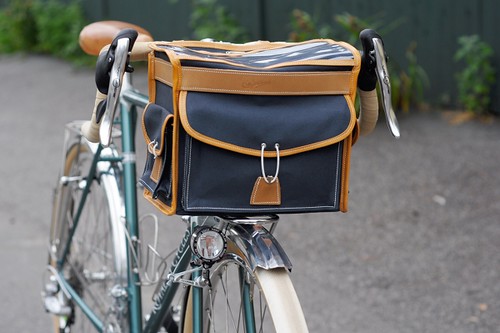 I finally received a Giles Berthoud handlebar bag for the Randonneur. It's the Model 25 in gray, which is their medium size and features elastic ties for the pockets instead of leather straps.
I finally received a Giles Berthoud handlebar bag for the Randonneur. It's the Model 25 in gray, which is their medium size and features elastic ties for the pockets instead of leather straps. The visual presence of this bag is almost too much for me. There is something about its colour scheme and construction that says "I am French and I am exquisite," and I find this both interesting and intimidating.
The visual presence of this bag is almost too much for me. There is something about its colour scheme and construction that says "I am French and I am exquisite," and I find this both interesting and intimidating.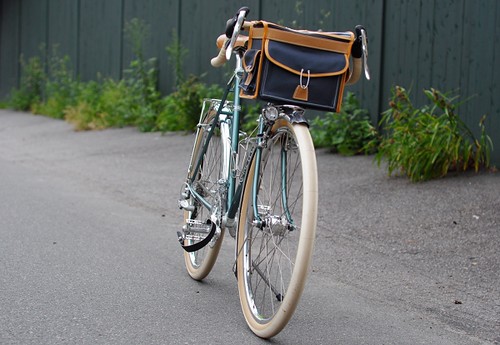 But happily, the Berthoud does not overwhelm the aesthetics of the bicycle. The size is a perfect fit. And the darker fabric and lighter leather combination parallels the contrast between the frame and lugwork. In comparison, the Ostrich handlebar bag on my own bike is more drab and also more bulky.
But happily, the Berthoud does not overwhelm the aesthetics of the bicycle. The size is a perfect fit. And the darker fabric and lighter leather combination parallels the contrast between the frame and lugwork. In comparison, the Ostrich handlebar bag on my own bike is more drab and also more bulky. The bag has a large front pocket,
The bag has a large front pocket, two side pockets
two side pockets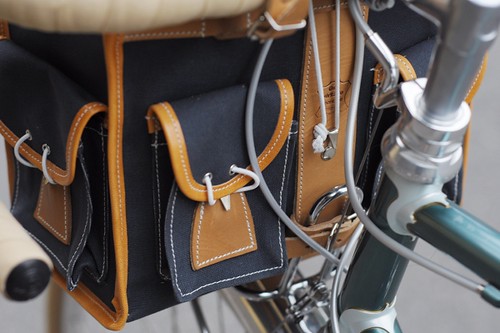 and two rear pockets. The top flap closes toward, rather than away from the cyclist, which is the opposite of what I am used to with the Ostrichand makes it counterintuitive for me to use - but this is of course user-specific. You can see that leather straps are provided for wrapping around the back of the rack. However, there are no provisions for securing the bag to the rack's platform, which surprised me (Ostrich includes straps for this). I know that some devise DIY systems, and if you've done so I'd love to hear about your process.
and two rear pockets. The top flap closes toward, rather than away from the cyclist, which is the opposite of what I am used to with the Ostrichand makes it counterintuitive for me to use - but this is of course user-specific. You can see that leather straps are provided for wrapping around the back of the rack. However, there are no provisions for securing the bag to the rack's platform, which surprised me (Ostrich includes straps for this). I know that some devise DIY systems, and if you've done so I'd love to hear about your process.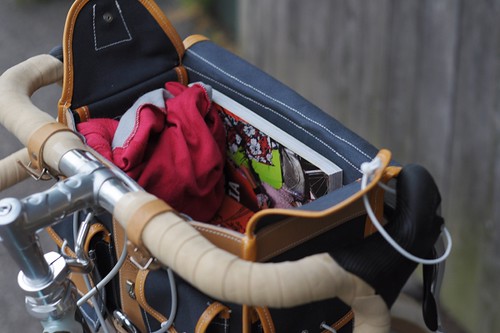 There are leather straps provided for attaching the bag to the handebars, though most opt for installing a decaleur. And here is where we are experiencing a little glitch. Ideally, the owner would prefer to forgo a decaleur: He plans to ride both with and without the bag, and a bagless decaleur sticking out of the bicycle doesn't look great (I agree). The handlebar straps hold the bag up fine, but without being secured on the bottom it bounces on the rack when filled with stuff and going over bumps. I am also told that the bag can move from side to side without a decaleur, though I haven't experienced thisyetduring my one test ride so far(with 10lb of weight in the bag).
There are leather straps provided for attaching the bag to the handebars, though most opt for installing a decaleur. And here is where we are experiencing a little glitch. Ideally, the owner would prefer to forgo a decaleur: He plans to ride both with and without the bag, and a bagless decaleur sticking out of the bicycle doesn't look great (I agree). The handlebar straps hold the bag up fine, but without being secured on the bottom it bounces on the rack when filled with stuff and going over bumps. I am also told that the bag can move from side to side without a decaleur, though I haven't experienced thisyetduring my one test ride so far(with 10lb of weight in the bag). As far as decaleurs go, we had planned to use one of theseif going without proved impossible, but I have since been warned that using it with the Nitto lugged stem (as opposed to the regular Technomic stem) is not a good idea, for complicated reasons related to clamp compatibility that I won't go into here. An alternative would be Berthoud's own decaleur, but it too apparently presents issues with the lugged stem - plus it is fairly obtrusive without the bag on. A headset-mounted decaleur is not possible here, because it would sit too low. So I am seeking a solution, and also wondering whether securing the bag at the bottom would in itself solve the problem. The bag is not nearly as large as my Ostrich, and I know that some do manage to use it without a decaleur. Sharing of experiences in this regard would be most appreciated.
As far as decaleurs go, we had planned to use one of theseif going without proved impossible, but I have since been warned that using it with the Nitto lugged stem (as opposed to the regular Technomic stem) is not a good idea, for complicated reasons related to clamp compatibility that I won't go into here. An alternative would be Berthoud's own decaleur, but it too apparently presents issues with the lugged stem - plus it is fairly obtrusive without the bag on. A headset-mounted decaleur is not possible here, because it would sit too low. So I am seeking a solution, and also wondering whether securing the bag at the bottom would in itself solve the problem. The bag is not nearly as large as my Ostrich, and I know that some do manage to use it without a decaleur. Sharing of experiences in this regard would be most appreciated.





















































